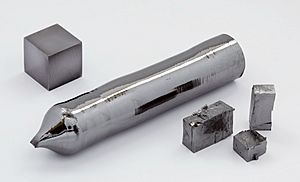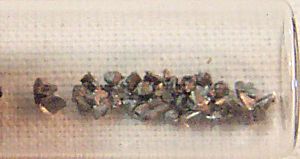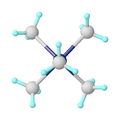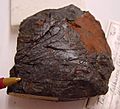Tantalum facts for kids
 |
||||||||||||||||||||||||||||||||||||||||||||||||
| Tantalum | ||||||||||||||||||||||||||||||||||||||||||||||||
|---|---|---|---|---|---|---|---|---|---|---|---|---|---|---|---|---|---|---|---|---|---|---|---|---|---|---|---|---|---|---|---|---|---|---|---|---|---|---|---|---|---|---|---|---|---|---|---|---|
| Pronunciation | /ˈtæntələm/ |
|||||||||||||||||||||||||||||||||||||||||||||||
| Appearance | gray blue | |||||||||||||||||||||||||||||||||||||||||||||||
| Standard atomic weight Ar, std(Ta) | 180.94788(2) | |||||||||||||||||||||||||||||||||||||||||||||||
| Tantalum in the periodic table | ||||||||||||||||||||||||||||||||||||||||||||||||
|
||||||||||||||||||||||||||||||||||||||||||||||||
| Atomic number (Z) | 73 | |||||||||||||||||||||||||||||||||||||||||||||||
| Group | group 5 | |||||||||||||||||||||||||||||||||||||||||||||||
| Period | period 6 | |||||||||||||||||||||||||||||||||||||||||||||||
| Block | d | |||||||||||||||||||||||||||||||||||||||||||||||
| Electron configuration | [Xe] 4f14 5d3 6s2 | |||||||||||||||||||||||||||||||||||||||||||||||
| Electrons per shell | 2, 8, 18, 32, 11, 2 | |||||||||||||||||||||||||||||||||||||||||||||||
| Physical properties | ||||||||||||||||||||||||||||||||||||||||||||||||
| Phase at STP | solid | |||||||||||||||||||||||||||||||||||||||||||||||
| Melting point | 3290 K (3017 °C, 5463 °F) | |||||||||||||||||||||||||||||||||||||||||||||||
| Boiling point | 5731 K (5458 °C, 9856 °F) | |||||||||||||||||||||||||||||||||||||||||||||||
| Density (near r.t.) | 16.69 g/cm3 | |||||||||||||||||||||||||||||||||||||||||||||||
| when liquid (at m.p.) | 15 g/cm3 | |||||||||||||||||||||||||||||||||||||||||||||||
| Heat of fusion | 36.57 kJ/mol | |||||||||||||||||||||||||||||||||||||||||||||||
| Heat of vaporization | 753 kJ/mol | |||||||||||||||||||||||||||||||||||||||||||||||
| Molar heat capacity | 25.36 J/(mol·K) | |||||||||||||||||||||||||||||||||||||||||||||||
Vapor pressure
|
||||||||||||||||||||||||||||||||||||||||||||||||
| Atomic properties | ||||||||||||||||||||||||||||||||||||||||||||||||
| Oxidation states | −3, −1, +1, +2, +3, +4, +5 (a mildly acidic oxide) | |||||||||||||||||||||||||||||||||||||||||||||||
| Electronegativity | Pauling scale: 1.5 | |||||||||||||||||||||||||||||||||||||||||||||||
| Ionization energies |
|
|||||||||||||||||||||||||||||||||||||||||||||||
| Atomic radius | empirical: 146 pm | |||||||||||||||||||||||||||||||||||||||||||||||
| Covalent radius | 170±8 pm | |||||||||||||||||||||||||||||||||||||||||||||||
| Spectral lines of tantalum | ||||||||||||||||||||||||||||||||||||||||||||||||
| Other properties | ||||||||||||||||||||||||||||||||||||||||||||||||
| Natural occurrence | primordial | |||||||||||||||||||||||||||||||||||||||||||||||
| Crystal structure | body-centered cubic (bcc)
α-Ta |
|||||||||||||||||||||||||||||||||||||||||||||||
| Crystal structure | tetragonal
β-Ta |
|||||||||||||||||||||||||||||||||||||||||||||||
| Speed of sound thin rod | 3400 m/s (at 20 °C) | |||||||||||||||||||||||||||||||||||||||||||||||
| Thermal expansion | 6.3 µm/(m⋅K) (at 25 °C) | |||||||||||||||||||||||||||||||||||||||||||||||
| Thermal conductivity | 57.5 W/(m⋅K) | |||||||||||||||||||||||||||||||||||||||||||||||
| Electrical resistivity | 131 nΩ⋅m (at 20 °C) | |||||||||||||||||||||||||||||||||||||||||||||||
| Magnetic ordering | paramagnetic | |||||||||||||||||||||||||||||||||||||||||||||||
| Molar magnetic susceptibility | +154.0·10−6 cm3/mol (293 K) | |||||||||||||||||||||||||||||||||||||||||||||||
| Young's modulus | 186 GPa | |||||||||||||||||||||||||||||||||||||||||||||||
| Shear modulus | 69 GPa | |||||||||||||||||||||||||||||||||||||||||||||||
| Bulk modulus | 200 GPa | |||||||||||||||||||||||||||||||||||||||||||||||
| Poisson ratio | 0.34 | |||||||||||||||||||||||||||||||||||||||||||||||
| Mohs hardness | 6.5 | |||||||||||||||||||||||||||||||||||||||||||||||
| Vickers hardness | 870–1200 MPa | |||||||||||||||||||||||||||||||||||||||||||||||
| Brinell hardness | 440–3430 MPa | |||||||||||||||||||||||||||||||||||||||||||||||
| CAS Number | 7440-25-7 | |||||||||||||||||||||||||||||||||||||||||||||||
| History | ||||||||||||||||||||||||||||||||||||||||||||||||
| Discovery | Anders Gustaf Ekeberg (1802) | |||||||||||||||||||||||||||||||||||||||||||||||
| Recognized as a distinct element by | Heinrich Rose (1844) | |||||||||||||||||||||||||||||||||||||||||||||||
| Main isotopes of tantalum | ||||||||||||||||||||||||||||||||||||||||||||||||
|
||||||||||||||||||||||||||||||||||||||||||||||||
Tantalum is a chemical element. Tantalum was named tantalium. It has the chemical symbol Ta. It has the atomic number 73. It is a rare metal. It is hard and blue-gray. In chemistry it is placed in a group of metal elements named the transition metals.
Tantalum does not easily corrode. It is found in the mineral tantalite.
| Periodic table | |||||||||||||||||||||||||||||||||||||||||
|---|---|---|---|---|---|---|---|---|---|---|---|---|---|---|---|---|---|---|---|---|---|---|---|---|---|---|---|---|---|---|---|---|---|---|---|---|---|---|---|---|---|
| H | He | ||||||||||||||||||||||||||||||||||||||||
| Li | Be | B | C | N | O | F | Ne | ||||||||||||||||||||||||||||||||||
| Na | Mg | Al | Si | P | S | Cl | Ar | ||||||||||||||||||||||||||||||||||
| K | Ca | Sc | Ti | V | Cr | Mn | Fe | Co | Ni | Cu | Zn | Ga | Ge | As | Se | Br | Kr | ||||||||||||||||||||||||
| Rb | Sr | Y | Zr | Nb | Mo | Tc | Ru | Rh | Pd | Ag | Cd | In | Sn | Sb | Te | I | Xe | ||||||||||||||||||||||||
| Cs | Ba | La | Ce | Pr | Nd | Pm | Sm | Eu | Gd | Tb | Dy | Ho | Er | Tm | Yb | Lu | Hf | Ta | W | Re | Os | Ir | Pt | Au | Hg | Tl | Pb | Bi | Po | At | Rn | ||||||||||
| Fr | Ra | Ac | Th | Pa | U | Np | Pu | Am | Cm | Bk | Cf | Es | Fm | Md | No | Lr | Rf | Db | Sg | Bh | Hs | Mt | Ds | Rg | Cn | Uut | Fl | Uup | Lv | Uus | Uuo | ||||||||||
|
|||||||||||||||||||||||||||||||||||||||||
Images for kids
-
Tantalite, Pilbara district, Australia
-
Bimetallic coins minted by the Bank of Kazakhstan with silver ring and tantalum center. These ones feature the Apollo-Soyuz and the International Space Station
See also
 In Spanish: Tántalo (elemento) para niños
In Spanish: Tántalo (elemento) para niños

All content from Kiddle encyclopedia articles (including the article images and facts) can be freely used under Attribution-ShareAlike license, unless stated otherwise. Cite this article:
Tantalum Facts for Kids. Kiddle Encyclopedia.








